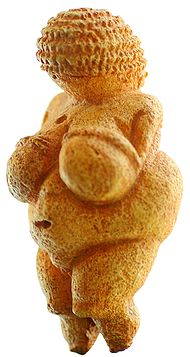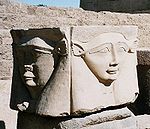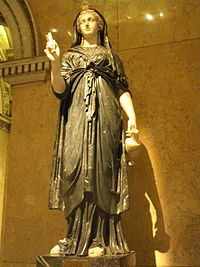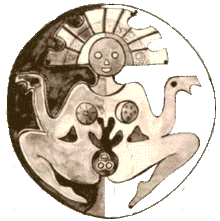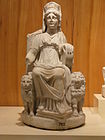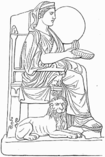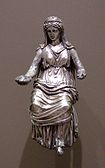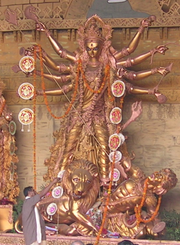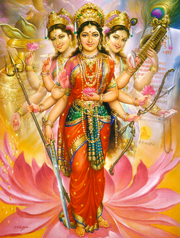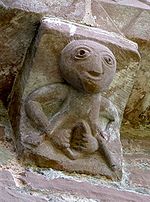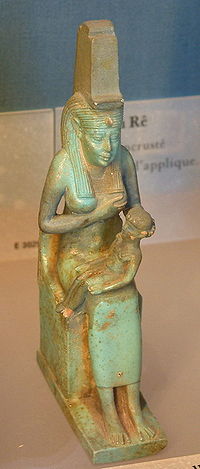- Mother goddess
-
Mother goddess is a term used to refer to a goddess who represents motherhood, fertility, creation or embodies the bounty of the Earth. When equated with the Earth or the natural world such goddesses are sometimes referred to as Mother Earth or as the Earth Mother.
Many different goddesses have represented motherhood in one way or another, and some have been associated with the birth of humanity as a whole. Others have represented the fertility of the earth.
Contents
Old Europe model
James Frazer (author of The Golden Bough) and those he influenced (such as Robert Graves and Marija Gimbutas) advance the theory that all worship in Europe and the Aegean that involved any kind of mother goddess had originated in Pre-Indo-European neolithic matriarchies, and that their diverse goddesses were equivalent to or derived from that concept. Gimbutas argued that the all images of motherhood from the period represented a universal conception of motherhood.
Although the type described by Gimbutas has been well accepted as a useful category for mythography, the idea that all such goddesses were believed in ancient times to be interchangeable was countered in 1968 by the archaeologist Peter Ucko, who proposed instead that the many images found in graves and archaeological sites of these ancient cultures were toys.[1]
Paleolithic figures
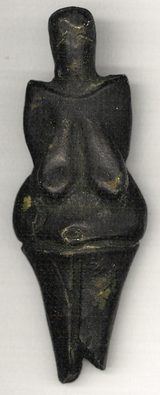 The Venus of Dolní Věstonice, one of the earliest known depictions of the human body, dates to approximately 29,000–25,000 BC (Gravettian culture of the Upper Paleolithic era)
The Venus of Dolní Věstonice, one of the earliest known depictions of the human body, dates to approximately 29,000–25,000 BC (Gravettian culture of the Upper Paleolithic era)
Several small, corpulent figures have been found during archaeological excavations of the Upper Paleolithic, the Venus of Willendorf, perhaps, being the most famous.[2] It is estimated to have been carved 24,000–22,000 BCE. Some archaeologists believe they were intended to represent goddesses, while others believe that they could have served some other purpose. These figurines predate the available records of the goddesses listed below as examples by many thousands of years, so although they seem to conform to the same generic type, it is not clear whether they, indeed, were representations of a goddess or that, if they are, there was any continuity of religion that connects them with Middle Eastern and Classical deities.
The Paleolithic period extends from 2.5 million years ago to the introduction of agriculture around 10,000 BCE. Archaeological evidence indicates that humans migrated to the Western Hemisphere before the end of the Paleolithic. It is the prehistoric era distinguished by the development of stone tools, and covers the greatest portion of humanity's time on Earth.
Neolithic figures
Diverse images of what are believed to be Mother Goddesses also have been discovered that date from the Neolithic period, the New Stone Age, which ranges from approximately 10,000 BCE when the use of wild cereals led to the beginning of farming, and eventually, to agriculture. The end of this Neolithic period is characterized by the introduction of metal tools as the skill appeared to spread from one culture to another, or arise independently as a new phase in an existing tool culture, and eventually became widespread among humans. Regional differences in the development of this stage of tool development are quite varied. In other parts of the world, such as Africa, South Asia, and Southeast Asia, independent domestication events led to their own patterns of development, while distinctive Neolithic cultures arose independently in Europe and Southwest Asia. During this time, native cultures appear in the Western Hemisphere, arising out of older traditions that were carried during migration. Regular seasonal occupation or permanent settlements begin to be seen in excavations. Herding and keeping of cattle, goats, sheep, and pigs is evidenced along with the presence of dogs. Almost without exception, images of what are interpreted as Mother Goddesses have been discovered in all of these cultures.
Deity examples
Many ancient cultures worshiped female deities who match the modern conception of a "mother goddess".
Egyptian
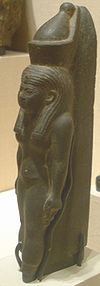 Statuette of Mut, mother, often interpreted as representing one of the earliest mother goddesses of Egypt
Statuette of Mut, mother, often interpreted as representing one of the earliest mother goddesses of Egypt
Mother goddesses are present in the earliest images discovered among the archaeological finds in Ancient Egypt. An association with animals seen as good mothers—the lioness, cow, hippopotamus, white vulture, cobra, scorpion, and cat—as well as the life-giving primordial waters, the sun, and the night sky and the earth herself—is drawn to the early goddesses of Egypt.
Even through the transition to a paired pantheon of male deities matched or "married" to each goddess, reached a later male deity dominated pantheon that arose much later, the mother goddesses persisted into historical times (such as Hathor and Isis). Advice from the oracles associated with these goddesses guided the rulers of Egypt.
The image of Isis nursing her son was worshiped into the sixth century A.D. and has been resurrected by contemporary "cults" of an Earth Mother.
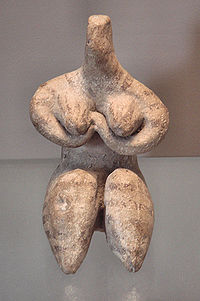 A figure often interpreted as a depiction of a mother goddess from Samarra, ca 6000 BCE (Louvre Museum)
A figure often interpreted as a depiction of a mother goddess from Samarra, ca 6000 BCE (Louvre Museum)
Indigenous people of the Americas
The indigenous peoples of the Andes worship the fertility goddess Pachamama. In Inca mythology, Pachamama presides over planting and harvesting and causes earthquakes. After conquest by Catholic Spain her image was masked by the Virgin Mary, behind whom she is invoked and worshiped in the Aboriginal ritual in some parts of Argentina, Chile, Bolivia and Peru.[3] The religion centered in the Pachamama is practiced currently in parallel form to Christianity, to the point that many families are simultaneously Christian and pachamamistas.[4] Pachamama is sometimes syncretized the Virgin of Candelaria.[5]
The Hopi people of North America (Turtle Island), Arizona, USA, refer to the Earth as Tuuwaqatsi-Earth Mother. According to the knowledge they have carefully preserved down the ages, the Earth is our "Land and our Life," which is remembered in their first law: Tutskwa I'qatsi - Land and Life are one. The Goddess-Earth has a male counterpart representing the inner life or core of the Earth. This inner life/soul/mind/womb is sometimes referred to as Maski, or spirit-home, the place people go following death. This place is sometimes referred to as the "underworld."
In Aztec mythology
In Aztec mythology, Toci is the "Mother of the Gods". She is often associated with Tlazolteotl, a central Mesoamerican goddess of both purification and filth, healing, and midwifery.
Sumerian, Mesopotamian, and Greek
Ninsun is the Mother Goddess in general Mesopotamian mythology, Asherah in Canaan and `Ashtart in Syria. The Sumerians wrote erotic poetry about their mother goddess Ninhursag.[6] In Greece she is Gaia; a Homeric Hymn (7-6 century BC) is dedicated to "Gaia, Mother of All".
Anatolia – Çatalhöyük
In Anatolia, the Neolithic settlement from 7500 BC, Çatalhöyük, was at first thought to have provided evidence of worship of a mother goddess. A striking feature of Çatalhöyük are its female figurines. James Mellaart, the original excavator, argued that these well-formed, carefully made figurines, carved and molded from marble, blue and brown limestone, schist, calcite, basalt, alabaster, and clay, represented a female deity of the Great Goddess type. Although a male deity existed as well, “…statues of a female deity far outnumber those of the male deity, who moreover, does not appear to be represented at all after Level VI”.[7] To date, eighteen levels have been identified. These careful figurines were found primarily in areas Mellaart believed to be shrines. One, however – a stately goddess seated on a throne flanked by two female lions – was found in a grain bin, which Mellaart suggests might have been a means of ensuring the harvest or protecting the food supply.[8]
Whereas Mellaart excavated nearly two hundred buildings in four seasons, the current excavator, Ian Hodder, spent an entire season excavating one building alone.[9] Hodder and his team, in 2004 and 2005, began to believe that the patterns suggested by Mellaart were false. They found one similar figurine, but the vast majority did not imitate the Mother Goddess style that Mellaart suggested. Instead of a Mother Goddess culture, Hodder points out that the site gives little indication of a matriarchy or patriarchy. <needs citation>
"There are full breasts on which the hands rest, and the stomach is extended in the central part... As one turns the figurine around one notices that the arms are very thin, and then on the back of the figurine one sees a depiction of either a skeleton or the bones of a very thin and depleted human. The ribs and vertebrae are clear, as are the scapulae and the main pelvic bones... [T]his is a unique piece that may force us to change our views of the nature of Catalhoyuk society and imagery."[10]In an article in the Turkish Daily News Hodder is reported as denying that Çatalhöyük was a matriarchal society and quoted as saying "When we look at what they eat and drink and at their social statues, we see that men and women had the same social status. There was a balance of power. Another example is the skulls found. If one's social status was of high importance in Çatalhöyük, the body and head were separated after death. The number of female and male skulls found during the excavations is almost equal."[11]
In a report in September 2009 on the discovery of around 2000 figurines Hodder is quoted as saying:
“Çatalhöyük was excavated in the 1960s in a methodical way, but not using the full range of natural science techniques that are available to us today. Sir James Mellaart who excavated the site in the 1960s came up with all sorts of ideas about the way the site was organised and how it was lived in and so on,” he said. “We’ve now started working there since the mid 1990s and come up with very different ideas about the site. One of the most obvious examples of that is that Çatalhöyük is perhaps best known for the idea of the mother goddess. But our work more recently has tended to show that in fact there is very little evidence of a mother goddess and very little evidence of some sort of female-based matriarchy. That’s just one of the many myths that the modern scientific work is undermining.”[12]
Another archaeologist, Lynn Meskell, explained that while the original excavations had found only 200 figures, the new excavations had uncovered 2000 figurines of which most were animals, with less than 5% of the figurines women.[12]
Cucuteni-Trypillian culture
From 5500 to 2750 BC the Cucuteni-Trypillian culture flourished in the region of modern-day Romania, Moldova, and southwestern Ukraine, leaving behind ruins of settlements of up to 15,000 residents who practiced agriculture, domesticated livestock, and many ceramic remains of pottery and clay figurines. Some of these figurines appear to represent the mother goddess (see images in this article).
Greek
In the Aegean, Anatolian, and ancient Near Eastern culture zones, a mother goddess was worshipped in the forms of Cybele (revered in Rome as Magna Mater, the 'Great Mother'), of Gaia, and of Rhea.
Gaia is a primordial deity in the Ancient Greek pantheon and considered a Mother Goddess or Great Goddess.
The Olympian goddesses of classical Greece had many characters with mother goddess attributes, including Hera and Demeter.[13]
The Minoan goddess represented in seals and other remains many of whose attributes were later also absorbed by Artemis, seems to have been a mother goddess type, for in some representations she suckles the animals that she holds.
The archaic local goddess worshiped at Ephesus, whose cult statue was adorned with necklaces and stomachers hung with rounded protuberances[14] who was later also identified by Hellenes with Artemis, was probably also a mother goddess.
The Anna Perenna Festival of the Greeks and Romans for the New Year, around March 15, near the Vernal Equinox, may have been a mother goddess festival. Since the Sun is considered the source of life and food, this festival was also equated with the Mother Goddess.
Roman
Gaia's equivalent in the Roman mythology was Terra Mater or Tellus Mater, sometimes worshiped in association with Demeter's Roman equivalent, Ceres, goddess of grain, agriculture and fertility, and mothering.[15]
Venus (Greek Aphrodite's equivalent), was mother of the Trojan Aeneas and ancestor of Romulus, Rome's mythical founder. In effect, she was the mother of Rome itself, and various Romans, including Julius Caesar, claimed her favour. In this capacity she was given cult as Venus Genetrix (Ancestor Venus). She was eventually included among the many manifestations of a syncretised Magna Dea (Great Goddess), who could be manifested as any goddess at the head of a pantheon, such as Juno or Minerva, or a goddess worshipped monotheistically.
Celtic
The Irish goddess Anu, sometimes known as Danu, has an impact as a mother goddess, judging from the Dá Chích Anann near Killarney, County Kerry. Irish literature names the last and most favored generation of deities as "the people of Danu" (Tuatha De Danann). The Welsh have a similar figure called Dôn who is often equated with Danu and identified as a mother goddess. Sources for this character date from the Christian period however so she is referred to simply as a mother of heroes in the Mabinogion. The character's (assumed) origins as a goddess are obscured.
The Celts of Gaul worshipped a goddess known as Dea Matrona ("divine mother goddess") who was associated with the Marne River. Similar figures known as the Matres (Latin for "mothers") are found on altars in Celtic as well as Germanic areas of Europe.
Germanic
In the 1st century BC, Tacitus recorded rites amongst the Germanic tribes focused on the goddess Nerthus, whom he calls Terra Mater, 'Mother Earth'. Prominent in these rites was the procession of the goddess in a wheeled vehicle through the countryside. Among the seven or eight tribes said to worship her, Tacitus lists the Anglii and the Longobardi.[16]
Among the later Anglo-Saxons, a Christianized charm known as Æcerbot survives from records from the 10th century. The charm involves a procession through the fields while calling upon the Christian God for a good harvest, invokes 'eorþan modor' (Earth Mother) and 'folde, fira modor,' (Earth, mother of men).
In skaldic poetry, the kenning "Odin's wife" is a common designation for the Earth. Bynames of the Earth in Icelandic poetry include Jörð, Fjörgyn, Hlóðyn and Hlín. Hlín is used as a byname of both Jörð and Frigg. Fjörgynn (a masculine form of Fjörgyn) is said to be Frigg's father, while the name Hlóðyn is most commonly linked to Frau Holle, as well as to a goddess, Hludana, whose name is found etched in several votive inscriptions from the Roman era.[17]
Connections have been proposed between the figure of Nerthus and various figures (particularly figures counted amongst the Vanir) recorded in 13th century Icelandic records of Norse mythology, including Frigg. Due to potential etymological connections, the Norse god Njörðr has been proposed as the consort of Nerthus.[18] In the Poetic Edda poem Lokasenna, Njörðr is said to have fathered his famous children by his own sister. This sister remains unnamed.
Due to specific terms used to describe the figure of Grendel's mother from the poem Beowulf, some scholars have proposed that the figure of Grendel's mother, like the poem itself, may have derived from earlier traditions originating from Germanic paganism.
Turkic Siberians
Yer Tanrı is the mother of Umai, also known as Ymai or Mai, the mother goddess of the Turkic Siberians. She is depicted as having sixty golden tresses, that resemble the rays of the sun. She is thought to have once been identical with Ot of the Mongols.
Hinduism
In Hinduism, Durga represents the empowering and protective nature of motherhood. From her forehead sprang Kali, who defeated Durga's enemy, Mahishasura). The divine Mother, Devi Adi parashakti, manifests herself in various forms, representing the universal creative force. She also gives rise to [Maya (illusion)|Maya]] (the illusory world) and to prakriti, the force that galvanizes the divine ground of existence into self-projection as the cosmos. The Earth itself is manifested by Parvati, Durga's previous incarnation. Hindu worship of the divine Mother can be traced back to early Vedic culture.
Shaktism
The form of Hinduism known as Shaktism is strongly associated with Vedanta, Samkhya, and Tantra Hindu philosophies and is ultimately monist. The feminine energy, Shakti, is considered to be the motive force behind all action and existence in the phenomenal cosmos. The cosmos itself is Shiva, the unchanging, infinite, immanent, and transcendent reality that is the Divine Ground of all being, the "world soul". Masculine potential is actualized by feminine dynamism, embodied in multitudinous goddesses who are ultimately reconciled in one. Mother Maya, Shakti, herself, can free the individual from demons of ego, ignorance, and desire that bind the soul in maya (illusion). Practitioners of the Tantric tradition focus on Shakti to free themselves from the cycle of karma.
Christianity
Depictions in the Church
The Normans had a major influence on English Romanesque architecture when they built a large numbers of Christian monasteries, abbeys, churches and cathedrals. These Romanesque styles originated in Normandy and became widespread in north western Europe, particularly in England, which has the largest number of surviving examples.
Sheela na Gig is a common stone carving found in Romanesque Christian churches scattered throughout Europe. The figures are found in Ireland, Great Britain, France, Spain, Switzerland, Norway, Belgium and in the Czech Republic. Their meaning is not clearly identifiable as Christian, and may be a concept that survived from ancient forms of yoni worship and sacred prostitution practiced in the goddess temples. Other common motifs on Christian churches of the same time period are spirals and ouroboros or dragons swallowing their tails, which is a reference to rebirth and regeneration, a concept well known in pantheism. Other creatures including the succubus make an appearance in the sculptural reliefs of the church that have a long history in the oral tradition of previous civilizations that preceded Christianity.
Blessed Virgin Mary
Some Christians regard the Blessed Virgin Mary, the Theotokos (or Mother of God) for many believers, as a "spiritual mother," since she not only fulfills a maternal role, but is often viewed as a protective and intercessory force, a divinely established mediator for humanity, but she is not worshiped as a divine "mother goddess". The Roman Catholic, Anglican, Oriental Orthodox, and Eastern Orthodox churches identify "the woman" described in Revelation 12 as the Virgin Mary because in verse 5 this woman is said to have given "birth to a son, a male child, destined to rule all the nations with an iron rod" whom they identify as Jesus Christ. Then, in verse 17 of Revelation 12, the Bible describes "the rest of her offspring" as "those who keep God's commandments and bear witness to Jesus." These Christians believe themselves to be the other "offspring" because they try to "keep God's commandments and bear witness to Jesus," and thus they embrace Mary as their "mother". They also cite John 19:26–27 where Jesus entrusts his mother to the Apostle John as evidence that Mary is the mother of all Christians, taking the command "behold your mother" to apply generally.
In 300 A.D., the Blessed Virgin Mary was worshipped as a Mother Goddess in the Christian sect Collyridianism, which was found throughout Saudi Arabia. Collyridianism was made up mostly of women followers and female priests. Followers of Collyridianism were known to make bread and wheat offerings to the Virgin Mary, along with other sacrificial practices. The cult was heavily condemned as heretical and schismatic by the Roman Catholic Church and was preached against by Epiphanius of Salamis, who exposed the group in his recollective writings titled Panarion.
As motherhood is a common recurring concept in all religions, The Blessed Virgin Mary receives many titles in the Roman Catholic Church, such as Queen of Heaven and Star of the Sea, that are familiar from earlier Near Eastern traditions. Due to this correlation, some Protestants often accuse Catholics of viewing Mary as a goddess, but the Roman Catholic Church and Orthodox churches always has condemned "worship as adoration" of the Virgin Mary. Part of this accusation is due to the Catholic practice of prayer as a means of communication rather than as a means of worship. Catholics believe that the dead who followed their God, have eternal life and can hear prayers in heaven from people here on earth. Concepts of Mother Goddess worshipped is heavily condemned by the Holy See as it had been suppressed and condemned among the Collyridianism sect in 300 A.D.
Sophia
The Bible refers to the personified Heavenly Wisdom (Hagia Sophia) in feminine terms. Sophia is venerated as the Virgin Sophia in Eastern and Oriental Orthodoxy, as well as in Christian Mysticism.
In many languages, such as Syriac, the word translated "spirit" takes the feminine gender. In early Christian literature in these languages, the Holy Spirit is therefore discussed in feminine terms, especially before c. A.D. 400.[19]
Traditionally, God is referred to by masculine titles and pronouns in Christianity, but the Bible occasionally does use feminine and maternal imagery in describing God. Christian beliefs about God and gender in Christianity vary widely. Most modern denominations officially teach that God transcends gender, but still use almost exclusively masculine language to refer to God; some officially discourage the use of feminine language, either on grounds of tradition or because they regard God as masculine in some important metaphorical way. However, some denominations including the United Church of Christ accept or even encourage language that sometimes describes God in feminine terms.
Mormonism
Members of The Church of Jesus Christ of Latter-day Saints (LDS Church) believe in, but do not worship, a Heavenly Mother, the wife and female counterpart—and equal of the Heavenly Father.[20] This belief is not emphasized, however, and adherents pray to the "Father in Heaven."
Neopaganism
Further information: Goddess (Wicca)The Mother Goddess, amalgamated and combined with various feminine figures from world cultures of both the past and present, is worshipped by modern Wicca and others (see Triple Goddess). The mother goddess is usually viewed as Mother Earth by these groups. More broadly, She is worshipped as Mother Nature, the Creatress of all life.
Wicca and some other Neo-Pagans worship the Mother Goddess. Most commonly she is worshiped as a Triple Goddess; usually envisioned as the Maiden, Mother, and Crone archetypes. She is associated with the full moon and stars, as well as the Earth and sea. Many ancient Pagan religions had mother goddesses; it has been argued that the figure of Mary the mother of Jesus is patterned on these.
The term "Great Goddess" refers to a mother goddess in some contemporary Neopagan and Wiccan religions.
Even among those who are not Pagan, expressions such as Mother Earth and Mother Nature are in common usage, personifying the Earth's ecology as a fertile and sustaining mother.
Earth Mother
The Earth Mother is a motif that appears in many mythologies. The Earth Mother is a fertile goddess embodying the fertile earth and typically the mother of other deities, and so, also are seen as patronesses of motherhood. This is generally thought of as being because the earth was seen as being the mother from whom all life sprang.
The Rigveda calls the Female power, Mahimata (R.V. 1.164.33), a term which literally means Great Mother.
In South America, contemporary Andean Indian peoples like Quechua and aymara believe in the Mother Earth Pachamama, whose worship cult is found in rural areas and towns at Ecuador, Peru, Bolivia, Northern Chile and Northwestern Argentina. Andean migrants carried the Pachamama cult to cities and many other extra-Andean places, including the Metropolitan Buenos Aires.
In various cultures
The idea that the fertile earth itself is female, nurturing mankind, was not limited to the Greco-Roman world. These traditions themselves were greatly influenced by earlier cultures in the ancient Middle East.In Sumerian mythology Ki is the earth goddess.In Akkadian orthography she has the syllabic values gi,ge,qi,qe (for toponyms).Some scholars identify her with Ninhursag (lady of the mountains),the earth and fertility Mother Goddess,who had the surnames Nintu (lady of birth), Mamma and Aruru.[21] The relevant Egyptian earth and fertility god Geb was male and he was considered as father of all snakes. The title "The mother of life" was later given to the Akkadian Goddess Kubau, and hence to Hurrian Hepa, emerging as Hebrew Eve (Heva) and Phygian Kubala (Cybele). In Norse mythology the earth is personified as Jörð, Hlöðyn, and Fjörgyn and Fjörgynn. In Germanic paganism, the Earth Goddess is referred to as Nertha.[22] The Irish Celts worshipped Danu, whilst the Welsh Celts worshipped Dôn. Hints of their names occur throughout Europe, such as the Don river, the Danube River, the Dnestr and Dnepr, suggest that they stemmed from an ancient Proto-Indo-European goddess.[23] In Lithuanian mythology Gaia - Žemė (Lithuanian for "Earth") is daughter of Sun and Moon. Also she is wife of Dangus (Lithuanian for "Sky") (Varuna). In Pacific cultures, the Earth Mother was known under as many names and with as many attributes as cultures who revered her, such as the Māori, whose creation myth included Papatuanuku, partner to Ranginui, the Sky Father. In South America in the Andes a cult of the Pachamama still survives (in regions of Bolivia, Peru, Ecuador, Argentina and Chile). The name comes from Pacha (Quechua for change, epoch) and Mama (mother). While ancient Mexican cultures referred to Mother Earth as Tonantzin Tlalli that means "Revered Mother Earth".
In Hinduism, the Mother of all creation is called "Gayatri". Gayatri is the name of one of the most important Vedic hymns consisting of twenty-four syllables. One of the sacred texts says, "The Gayatri is Brahma, Gayatri is Vishnu, Gayatri is Shiva, the Gayatri is Vedas" Gayatri later came to be personified as a Goddess. She is shown as having five heads and is usually seated within a lotus. The four heads of Gayatri represent the four Vedas and the fifth one represents almighty God. In her ten hands, she holds all the symbols of Lord Vishnu. She is another consort of Lord Brahma.
In Hinduism and Buddhism the specific local indwelling mother deity of Earth (as opposed to the mother deity of all creation) is called Bhūmi. Gautama Buddha called upon Bhumi as his witness when he achieved Enlightenment.
Phra Mae Thorani is recognized as the Goddess of the earth in Burma, Cambodia, Laos, Thailand and other Southeast Asian countries.
Only in Egyptian Mythology is the reverse true - Geb is the Earth Father while Nut is the Sky Mother.
In Mormonism, the Earth Goddess is called the Earth Spirit and according to Mormon theologian John A. Widstoe the Earth is a living being ensouled by the "Earth Spirit" and Widstoe states that in the Pearl of Great Price, the "Earth Spirit" is the being that spoke to Moses.[24]
In Theosophy, the Earth Goddess is called the "Planetary Logos of Earth".
In Wicca, the Earth Goddess is called Gaia. [25]
Carl Gustav Jung suggested that the archetypal mother was a part of the collective unconscious of all humans, and various Jungian students, e.g. Erich Neumann and Ernst Whitmont have argued that such mother imagery underpins many mythologies, and precedes the image of the paternal "father", in such religious systems. Such speculations help explain the universality of such mother goddess imagery around the world.
The Upper Paleolithic Venus figurines have been sometimes explained as depictions of an Earth Goddess similar to Gaia[26]
In Native American Indian storytelling, "The Earth Goddess" is one of several Creator-based titles and names given to the Spider Grandmother.
In fiction
In Gore Vidal's ironic dystopia "Messiah", a new death-worshipping religion sweeps the world and wipes out Christianity. Yet at the conclusion of the book, a woman named Iris, who was among the new religion's founders, starts to be worshipped as a new manifestation of the Mother Goddess, though there was no such concept when the religion was founded. Vidal's point was clearly to show that worship of the Mother Goddess is an immemorial institute and would find a manifestation within whatever religion emerges.
In Robert Graves' 1949 novel Seven Days in New Crete, a mother goddess is central to the religion of a quasi-matriarchal future society.
The Mother Goddess is referred to throughout the novel The Mists of Avalon by Marion Zimmer Bradley.
In the 2009 movie Avatar, the indigenous species at the center of the drama, the Na'vi, worship a mother goddess called Eywa.
See also
Figures
- Ananke
- Aphrodite
- Blessed Virgin Mary
- Brigid
- Cybele
- Demeter
- Devi
- Durga
- Eve
- Freyja
- Frigg
- Gaia
- Hathor
- Hecate
- Ishtar
- Isis
- Jord
- Kali
- Kamakhya
- Laxmi
- Mut
- Nerthus
- Ops
- Pachamama
- Potnia Theron
- Radha
- Rhea
- Shakti
- Tawaret
- Triple Goddess
- Yashoda
Other
- Breast shaped hill
- Çatalhöyük
- Dodona
- Father God
- God (male deity)
- God and gender
- Goddess
- Heavenly Mother
- Goddess movement
- Great Goddess, a disambiguation page
- Great Mother, a disambiguation page
- Mother
- Petrosomatoglyph
- Shitala Devi
- Sky father
Notes
- ^ Peter Ucko (1968) Anthropomorphic Figurines of Predynastic Egypt and Neolithic Crete
- ^ Venus of Willendorf Christopher L. C. E. Witcombe, 2003
- ^ Merlino, Rodolfo y Mario Rabey (1992). "Resistencia y hegemonía: Cultos locales y religión centralizada en los Andes del Sur". Allpanchis (40): 173–200.(Spanish)
- ^ Merlino, Rodolfo y Mario Rabey (1983). "Pastores del Altiplano Andino Meridional: Religiosidad, Territorio y Equilibrio Ecológico". Allpanchis (Cusco, Perú) (21): 149–171.(Spanish)
- ^ Manuel Paredes Izaguirre. "COSMOVISION Y RELIGIOSIDAD EN LA FESTIVIDAD". http://www.punomagico.com/festividad%20candelaria%202008%20Cosmovision%20andina.htm. Retrieved 2010-02-15.(Spanish)
- ^ Sex, Love & Eroticism in Mesopotamian Literature, G, Leick, Routledge, 2003
- ^ Mellaart, James (1967). Catal Huyuk: A Neolithic Town in Anatolia. McGraw-Hill. p. 181.
- ^ Mellaart (1967), 180.
- ^ Balter, Michael (2005). The Goddess and the Bull. New York: Free Press. p. 127. ISBN 0-7432-4360-9.
- ^ Hodder, Ian (2005). "New finds and new interpretations at Çatalhöyük". Çatalhöyük 2005 Archive Report. Catalhoyuk Research Project, Institute of Archaeology. http://www.catalhoyuk.com/archive_reports/2005/ar05_01.html.
- ^ Hodder, Ian (2008-01-17). "A Journey to 9000 years ago". http://www.turkishdailynews.com.tr/article.php?enewsid=93856. Retrieved 2008-08-07.
- ^ a b O'Brien, Jeremy "New techniques undermine 'mother goddess' role in the community" Irish Times September 20, 2009 [1]
- ^ "The goddesses of Greek polytheism, so different and complementary," Walter Burkert has observed, in Homo Necans (1972) 1983:79f, "are nonetheless, consistently similar at an earlier stage, with one or the other simply becoming dominant in a sanctuary or city. Each is the Great Goddess presiding over a male society; each is depicted in her attire as Mistress of the Beasts, and Mistress of the Sacrifice, even Hera and Demeter."
- ^ The description of them as multiple breasts or bull testicles seem mistaken: see Temple of Artemis.
- ^ Spaeth, Barbette Stanley, The Roman goddess Ceres, University of Texas Press, 1996, p. 34ff.googlebooks preview
- ^ Germania, ch. 40.
- ^ Rudolf Simek, Dictionary of Northern Mythology (1984).
- ^ Davidson, Hilda R. Ellis. Gods and Myths of Northern Europe (1964) ISBN 0-14-013627-4
- ^ Harvey, Susan Ashbrook (August , 2006). "Women in the Syrian Tradition: Part 2 – Holy Images". The Syriac Orthodox Christian Digest Volume 2, Issue 9. http://www.socdigest.org/articles/08aug06.html. Retrieved 2007-03-15.
- ^ Smith, Joseph F. (1909). Man: Origin and Destiny. pp. 348–355.
- ^ Dalley Stephanie.Myths from Mesopotamia.Oxford University Press. p.326 ISBN 978-0-19-283589-5
- ^ "Nerthus, Strength of the Earth" by Diana L. Paxson Sage Woman magazine Issue 79 Autumn 2010 “Connecting to Gaia” Pages 35-42
- ^ Indo-European scholars at sybalist suggest *Don may come from a Proto-Indo-European root meaning "Swift" as applied to the flowing rivers mentioned
- ^ Widstoe, John A. A Rational Theology Salt Lake City, Utah:1915 Bookcraft
- ^ "Sage Woman" magazine Issue 79 Autumn 2010--special issue "Connecting to Gaia"
- ^ Christopher L. C. E. Witcombe, "Women in the Stone Age," in the essay "The Venus of Willendorf" (accessed March 13, 2008)
Further reading
- Marija Gimbutas. The language of the Goddess. Harpercollins (1989). ISBN 0-06-250356-1
- Neumann, Erich. (1991). The Great Mother. Bollingen; Repr/7th edition. Princeton University Press, Princeton, NJ. ISBN 0-691-01780-8.
- J.F. del Giorgio. The Oldest Europeans. A.J. Place (2006). ISBN 980-6898-00-1
- Goldin, Paul R. (2002) "On the Meaning of the Name Xi wangmu, Spirit-Mother of the West." Paul R. Goldin. Journal of the American Oriental Society, Vol. 122, No. 1/January–March 2002, pp. 83–85.
- Prof. P.C. Jain: Conception and Evolution of The Mother Goddess in India 2004
- Knauer, Elfried R.(2006)"The Queen Mother of the West: A Study of the Influence of Western Prototypes on the Iconography of the Taoist Deity." In: Contact and Exchange in the Ancient World. Ed. Victor H. Mair. University of Hawai'i Press. Pp. 62–115. ISBN ISBN 978-0-8248-2884-4; ISBN ISBN 0-8248-2884-4
External links
- Reflections on Erta as named on the Franks Casket by Alfred Becker (PhD)
Categories:- Prehistory
- Prehistoric religion
- Earth goddesses
- Goddesses
- Mother goddesses
- Comparative mythology
- Mythological archetypes
- Paganism
- Feminist theology
- Feminist spirituality
- Motherhood
- Jungian archetypes
- Matriarchy
- Figurines
- Names of God
Wikimedia Foundation. 2010.

